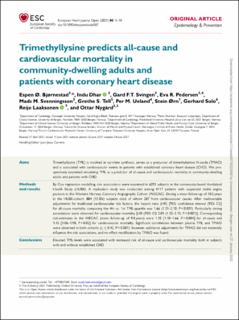| dc.contributor.author | Bjørnestad, Espen Øglænd | |
| dc.contributor.author | Dhar, Indu | |
| dc.contributor.author | Svingen, Gard Frodahl Tveitevåg | |
| dc.contributor.author | Pedersen, Eva Kristine Ringdal | |
| dc.contributor.author | Svenningsson, Mads Malm | |
| dc.contributor.author | Tell, Grethe Seppola | |
| dc.contributor.author | Ueland, Per Magne | |
| dc.contributor.author | Ørn, Stein | |
| dc.contributor.author | Sulo, Gerhard | |
| dc.contributor.author | Laaksonen, Reijo | |
| dc.contributor.author | Nygård, Ottar Kjell | |
| dc.date.accessioned | 2022-02-21T12:27:09Z | |
| dc.date.available | 2022-02-21T12:27:09Z | |
| dc.date.created | 2021-11-29T13:50:46Z | |
| dc.date.issued | 2021 | |
| dc.identifier.issn | 2752-4191 | |
| dc.identifier.uri | https://hdl.handle.net/11250/2980509 | |
| dc.description.abstract | Aims
Trimethyllysine (TML) is involved in carnitine synthesis, serves as a precursor of trimethylamine N-oxide (TMAO) and is associated with cardiovascular events in patients with established coronary heart disease (CHD). We prospectively examined circulating TML as a predictor of all-cause and cardiovascular mortality in community-dwelling adults and patients with CHD.
Methods and results
By Cox regression modelling, risk associations were examined in 6393 subjects in the community-based Hordaland Health Study (HUSK). A replication study was conducted among 4117 patients with suspected stable angina pectoris in the Western Norway Coronary Angiography Cohort (WECAC). During a mean follow-up of 10.5 years in the HUSK-cohort, 884 (13.8%) subjects died, of whom 287 from cardiovascular causes. After multivariable adjustments for traditional cardiovascular risk factors, the hazard ratio (HR) [95% confidence interval (95% CI)] for all-cause mortality comparing the 4th vs. 1st TML-quartile was 1.66 (1.31–2.10, P < 0.001). Particularly strong associations were observed for cardiovascular mortality [HR (95% CI) 2.04 (1.32–3.15, P = 0.001)]. Corresponding risk-estimates in the WECAC (mean follow-up of 9.8 years) were 1.35 [1.10–1.66, P = 0.004] for all-cause and 1.45 [1.06–1.98, P = 0.02] for cardiovascular mortality. Significant correlations between plasma TML and TMAO were observed in both cohorts (rs ≥ 0.42, P < 0.001); however, additional adjustments for TMAO did not materially influence the risk associations, and no effect modification by TMAO was found.
Conclusions
Elevated TML-levels were associated with increased risk of all-cause and cardiovascular mortality both in subjects with and without established CHD. | en_US |
| dc.language.iso | eng | en_US |
| dc.publisher | Oxford University Press | en_US |
| dc.rights | Navngivelse-Ikkekommersiell 4.0 Internasjonal | * |
| dc.rights.uri | http://creativecommons.org/licenses/by-nc/4.0/deed.no | * |
| dc.title | Trimethyllysine predicts all-cause and cardiovascular mortality in community-dwelling adults and patients with coronary heart disease | en_US |
| dc.type | Journal article | en_US |
| dc.type | Peer reviewed | en_US |
| dc.description.version | publishedVersion | en_US |
| dc.rights.holder | Copyright The Author(s) 2021 | en_US |
| dc.source.articlenumber | oeab007 | en_US |
| cristin.ispublished | true | |
| cristin.fulltext | original | |
| cristin.qualitycode | 1 | |
| dc.identifier.doi | 10.1093/ehjopen/oeab007 | |
| dc.identifier.cristin | 1960895 | |
| dc.source.journal | European Heart Journal Open (EHJ Open) | en_US |
| dc.identifier.citation | European Heart Journal Open. 2021, 1 (1), oeab007. | en_US |
| dc.source.volume | 1 | en_US |
| dc.source.issue | 1 | en_US |

